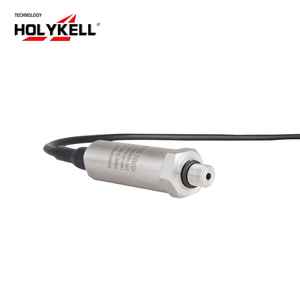
All categories
Featured selections
Trade Assurance
Buyer Central
Help Center
Get the app
Become a supplier

(3773 products available)




















































A water level pressure transducer is a device that helps measure the water level in tanks or other places where water is stored. As the water pressure changes, the transducer sends an electronic signal that tells how deep the water is. Here's a closer look at the various types:
Hydrostatic pressure transducers measure the pressure of water at the bottom of lakes, rivers, or any body of water. This pressure increases as the water above pushes down. These transducers are waterproof and help measure how deep water is by converting pressure to an electrical signal.
Differential pressure transducers measure the difference in pressure between two points. For example, they can measure water levels by checking the pressure at the bottom and top of a tank. If one side has more pressure, it tells the transducer that the water level has changed. These devices are often used in big tanks or pipelines where precise measurements are needed.
As the name suggests, submersible pressure transducers are pressure sensors that are designed to work under the water. They are specially made to work in tough places like deep wells or under heavy water. Submersible transducers measure the pressure of water above them to figure out the level. This is useful for checking water in places hard to reach otherwise.
Capacitive level transducers work a little differently by measuring how much water fills a tank or container. Even though they use a capacitor, which stores tiny electric charges, they still help check water levels. They are helpful for measuring the level of liquids in storage tanks. Unlike pressure transducers, capacitive sensors don't need to touch the liquid to work well.
Transducers are key in industry for controlling and monitoring important systems. Here is a closer look at how these sensors help:
In chemical processing plants, transducers help keep the right amount of chemicals mixed together. They monitor the levels in tanks and pipelines to avoid overflow or running too low. This water level pressure transducer ensures that reactions happen as needed without safety problems. Their precise readings enable automated systems to regulate valves and pumps.
Transducers are used to check water levels in pipelines, reservoirs, and injection/production wells. They measure pressure changes to monitor fluid flow and detect blockages or leaks early on. This keeps operations safe. Transducers also assist with pressure control during drilling.
Water management is crucial in mining, as excess water can damage equipment or slow down work. Transducers are used to measure levels in pits, ponds, and other areas to track water amounts. This water pression transducer allows miners to better manage pumping and reduce flooding risks.
In drug-making factories, transducers help ensure the right water levels are maintained in complicated heating and cooling systems. They monitor tanks and use their precise readings to automatically adjust valves and pumps, helping the pharmaceutical factory make medication safely with consistent quality.
For farms and agriculture, transducers help keep irrigation systems watering crops properly. They measure water pressure and levels in storage tanks and pipelines. By tracking these amounts, transducers allow irrigation systems to run automatically based on crop needs without wasting water.
Water pressure transducers function by correlating water depth with pressure. They convert the pressure exerted by a column of water into an electronic signal. To understand this better, let's relate it to something people see daily – measuring a cup of water. Just like noticing the height of water fills the cup to a certain level, transducers measure the pressure at various depths. When accuracy is vital, differential pressure transducers come into play. They measure the pressure difference between two points, ensuring precise water level readings.
Think about how big the tank or space will be where the transducer will be placed. For small tanks, simple sensors work well. More difficult situations might need more advanced pressure sensors. Choosing one that matches the right size for the job will help things go smoothly.
Make sure the transducer can work with the liquids or situations it will be around. Some sensors deal with hot temperatures or fluids with chemicals inside that can damage other sensors. Getting one that withstands these things ensures long-lasting performance without breaking down.
Think about how exactly the levels need to be measured. If a very precise reading is required, choosing one with tighter calibration is important. For most common tasks, the basic models will work just fine measuring the average required depth without errors.
There are different kinds of transducers based on where they will be used. Some measure pressure in the air above the liquid. Others work underwater. Selecting the right one ensures correct readings. This avoids confusing signals and keeps everything on the right track.
A1: A water level pressure transducer is used to measure how high water is in tanks and other places by sensing the pressure the water pushes down.
A2: These transducers are used in factories, chemical plants, farms, and many other industries to automate processes and keep things running smoothly.
A3: It senses the pressure and sends a small electrical signal, from 4 to 20 milliamps, which indicates how deep or high the water is for monitoring systems.
A4: Yes, many are designed to work in extreme climates, with waterproof seals and materials that withstand high temperatures and pressure.
A5: By precisely measuring water levels, it controls pumps and valves to prevent overflow or emptying, saving energy and avoiding problems in operations.